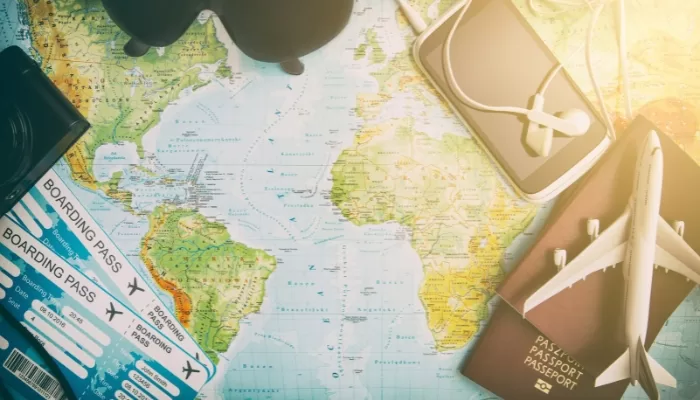Travel
From Costs to Collaboration: Modern Trends Shaping Business Travel

- Businesses are moderating travel costs due to economic pressures, including rising fuel prices and currency fluctuations.
- Technological advancements like virtual meetings and travel management software are reducing the need for physical travel.
- Companies are focusing on sustainability, employee well-being, and adapting to new business models like remote work to manage travel expenses.
Business travel, a key component of worldwide commerce, has long been a considerable expense for businesses. However, in recent years, there has been a shift toward lowering these expenses, owing to a combination of economic pressures, technical breakthroughs, and shifting business models. This paper delves into the fundamental reasons driving this trend and how firms are altering their strategy to maximize travel expenses.
Economic Pressures Shape Business Travel Costs
- Global Recession and Economic Uncertainty: Following the 2008 financial crisis and following economic downturns, businesses have reassessed their expenditure priorities. Travel expenses, which are generally viewed as discretionary, are coming under closer examination as businesses look to reduce their budgets.
- Rising Fuel Prices: Fuel price fluctuations have a direct impact on air travel, ground transportation, and lodging expenditures. In response, corporations are looking into strategies to better control these costs.
- Currency fluctuations: Exchange rate volatility can greatly affect the cost of overseas travel. Businesses are implementing techniques to mitigate currency risks and reduce exposure to volatile exchange rates.
Technological Advancements Reducing Travel Needs
- Virtual Meetings and Conferences: The rise of video conferencing platforms such as Zoom, Teams, and Google Meet transformed remote collaboration. These solutions allow teams to efficiently engage without the need for real meetings, resulting in reduced trip frequency.
- Mobile Devices and Productivity Tools: Advances in mobile technology enable employees to operate remotely while accessing critical information on the go. This improvement eliminates the need for some forms of business travel, such as short-term meetings or data gathering visits.
- Travel Management Software: Sophisticated travel management systems have simplified the booking process, allowing businesses to negotiate better prices, track expenditure, and implement travel regulations. These tools also make it easier to make data-driven decisions, which helps to save money on travel.
Changes in Business Models Impact Travel
- Remote work and flexible offices: The rise of remote work and flexible office arrangements has reduced the demand for traditional business travel. Employees can now carry out their jobs from locations closer to home, eliminating the need for long journeys or overnight stays.
- Freelancing and the Gig Economy: The rise of the freelance and gig economies has resulted in a more scattered workforce. This distribution can reduce the frequency of business travel because team members may be scattered across multiple locations.
- Regionalization and localization: In order to reduce long-distance travel, many businesses are shifting their attention to regional or local markets. Organizations can reduce their need for frequent international trips by increasing their presence in key markets.
Environmental and Employee Wellbeing Considerations
- Sustainable and Corporate Social Responsibility: There is an increasing understanding of the environmental impact of business operations, particularly travel. Companies are progressively implementing sustainable travel strategies, such as lowering carbon emissions and promoting eco-friendly lodgings.
- Government Regulations and Incentives: Governments are enacting regulations and incentives to encourage sustainable travel. This includes carbon taxes, fuel surcharges, and subsidies for ecologically friendly transportation options.
- Travel Fatigue and Burnout: Frequent business travel can harm employees’ physical and emotional wellbeing. Organizations are recognizing the importance of employee well-being and implementing policies to minimize excessive travel while ensuring appropriate rest and recovery.
- Work-Life Balance: As employees prioritize work-life balance, there is an increasing demand for flexible travel rules that allow for personal commitments while reducing travel-related stress.
What The Future Holds : Stability and Future Trends
Business travel is changing rapidly, making it critical for businesses to stay up to date on emerging trends and insights in order to properly plan and budget for the future.
- Price Stabilization: Following a period of instability, travel expenses are now stabilizing. This trend is projected to continue, creating a more predictable environment for business travel in the coming 24 months.
- Evolving Travel Patterns: After a significant upheaval during the epidemic, travel patterns are now settling into a new norm. This stabilization, which is partly attributable to a reduction in excess consumer demand, is resulting in more stable travel patterns.
- Alignment with Economic patterns: As global economic growth slows, business travel growth becomes more closely aligned with broader economic patterns. This alignment gives firms a more predictable rate of travel growth, which helps with long-term planning and expense control.
Understanding the economic and industrial dynamics will be critical for travel managers, executives, and regular business travelers. As we approach 2025, adapting to these developments will assist optimize travel strategy and maintain successful cost management.


















































